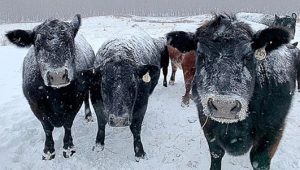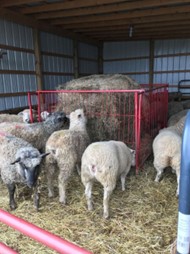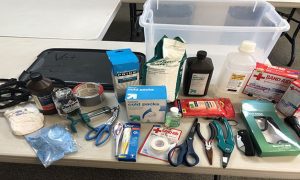Extreme Weather Preparedness for Livestock Operations
Author: Sara Tomis, Mary Ellen Welch, & MacKenzie White
sara.tomis@uconn.edu
Reviewers: Rachel Bespuda, UConn Extension
Publication EXT105 | February 2025
Extreme weather poses a significant risk to animal operations. Keeping livestock and farm families safe requires preparation before an extreme weather event. Work closely with local service providers, including veterinarians and Extension specialists, to develop a comprehensive plan. Stay alert to changes in weather and take action early to prepare for weather emergencies. Preparing in advance can help to mitigate the negative effects of natural disasters.
This factsheet is designed for livestock owners or managers seeking to prepare operations for severe weather events. A One Health approach is applied for understanding the interactions between humans, animals, and the environment.
Extreme Weather
Extreme weather events are increasing in frequency and intensity. Many of the observed weather changes are linked to human-induced change in the

climate. Greenhouse gas emissions, for example, have contributed to atmospheric temperature increases and volatile weather patterns. Examples of extreme weather that may impact livestock production include fire, flooding, wind, lightning, hurricanes, tornadoes, hailstorms, ice, blizzards (Figure 1), and drought.
Unique Considerations for Livestock Operations
Although extreme weather can impact all families and businesses, livestock production has unique characteristics to consider when preparing for severe weather. Livestock operations often include a greater number of animals than found in a typical household. The scope of the operation, and the size of the animals themselves, can make emergency response more challenging, when considering housing and transportation requirements. Furthermore, livestock feed must stay dry and free of contaminants and pests. Maintaining safe and high-quality feed along with providing access to clean water during and after a natural disaster may also be a challenge.
Recommendations for Livestock Operations
Have a written communication and response plan in place
Staying in touch is imperative during an extreme weather event. Sign up for local and state weather alerts. Develop a written communication and response plan that includes:
- Contact information for veterinarian, employees/family members, and someone who could care for animals on site if evacuation is ordered;
- A plan for evacuation;
- A plan for sheltering in place.
Having a written plan is important especially if power goes out, limiting phone and computer use. Make sure this plan is available for those who will need to use it. Review the plan together frequently and discuss any changes or contingency plans. Prepare the necessary materials needed to implement the plan, and store them in a secure place.
Maintain quality records
Keeping good records starts long before extreme weather. Records are important whether you stay or if you go during an emergency. If your livestock were to escape or be turned loose during a weather emergency, being able to accurately identify and prove ownership is imperative. Ear tags are not a permanent form of identification as they can get caught and be pulled out. Consider using chip technology, such as RFID, if appropriate for your species, or accompanying each tattoo with a tag. Have a picture of each animal and highlight distinct markings if possible. A picture of you and your livestock is the best, as it will support your ownership claim. Within your response plan, include copies of all registration and vaccine paperwork. Consider making a table that includes the identification information for each animal in your operation and any special considerations, such as breeding status, age, and special diets or medication needs. Print this out as well as storing it digitally, both on a computer and in the cloud.
Consider livestock vaccinations
Vaccines can make a significant impact on risk of infection for both livestock and human handlers. Vaccines such as rabies may be required when accessing emergency shelters, and are especially important if your animal were to get loose during an extreme weather event. Know the recommended vaccines for each species and area and work with your veterinarian to protect the herd or flock.
Have a plan for sheltering in place
If you decide to stay at home, or leave livestock at home, consider how you can best prepare them for survival:
- Secure all fencing;
- Consider enhancing the structural integrity of your barn (see Meader, 2018);
- Have a back-up plan for water if the electricity goes out. Consider purchasing battery-powered lights;
- Determine the most at-risk areas for flooding and remove all animals, feed, and chemicals/medication from that area;
- Identify who could check on your livestock or feed them if you were not able to;
- Prepare and maintain a livestock emergency kit (see recommendation #5).
Determine if you will leave livestock inside or turn them out to pasture. If you leave livestock in a barn, ensure the structural integrity of the barn, and that

there is no risk for flooding (especially for young and small animals). There should be enough space for all livestock to safely fit in the area(s) of the barn, and for you to separate males from females if it is not breeding season. Providing extra room for movement can also reduce stress in the animals. If possible and practical, remove sources of electricity to minimize the risk of fire. Clear the path so you can access them afterwards and provide plenty of bedding, fresh water, and hay (Figure 2). Feed can keep animals warm in extreme cold. Avoid changes to feed as much as possible to reduce additional stress on the animal.
If turning animals out to pasture, consider the weather. If it is going to be a blizzard, this may not be the best choice. Avoid using pastures with low-lying areas where flooding is possible, and where trees could damage fencing or knock electrical wires into the penned space. Ensure that all livestock have a permanent form of identification. Store away any items or potentially hazardous material that could cause injury or be blown into the pasture. Make sure they have access to water that is clean and not frozen. If you can safely monitor or check on your livestock during the weather event, this could help the animals maintain good health and/or prevent injury from occurring. Monitoring your livestock and recognizing and responding to any of their needs in a timely manner could include checking on their feed/water supply, providing additional bedding (extreme cold), cooling them down (extreme heat), and/or examining each animal for any injuries, signs of stress, or abnormal health symptoms (i.e., lacerations, frostbite, labored breathing).
Have a plan for evacuation
If you need to evacuate the area in response to an extreme weather event, know locations for sheltering. Evacuation should occur early, a few days before the anticipated weather event. This will help avoid traffic delays and help animals to settle into their new environment without the added stress of extreme weather. Identify at least two locations ahead of time: one in-state, and one out-of-state. Contact your town and/or county for information on emergency animal shelter locations, like fairgrounds. Be prepared to be flexible with multiple back-up plans. Have written contact information for each location, including written directions for how to get to each location. Planning for multiple routes to the evacuation locations can help prepare for were traffic or road condition challenges.
Consider how you will transport your livestock:
- Ensure that you have reliable access to a trailer and a vehicle to pull it. Check tires monthly for flats. If you are relying on a friend or neighbor, coordinate in advance;
- Determine how many trips you need to take and how long it will take you for each trip;
- Consider how many animals you can fit in the trailer at a time and if they need to be separated;
- Determine if you will need help getting livestock on and off of trailers. Coordinate this information in advance and ensure that all helpers are trained to safely work with all animal species;
- Try to avoid anything new during extreme weather events–practice so your animals and helpers will be familiar with the evacuation routine.
When planning for evacuation, consider what you will need to bring with you. Determine how much feed you need and how you will store it. Ensure that there is a source of clean water at the location.
Prepare a livestock emergency kit
Prepare what you can in advance. Make a list of what you would need to grab during an evacuation, such as medication and feed. Review your kit frequently and keep it well-stocked.
You may choose to include:
- Hay, grain, and water for at least 7 days or more;
- Buckets/troughs for food & water;
- Halters & lead ropes;
- Panels or portable fencing for confinement;
- Bedding (straw, shavings, etc.);
- Towels;
-

Figure 3. Livestock first aid kit. Photo source Craig et al., Clemson University Medicine (watch for refrigeration) & livestock first aid kit containing all necessary medical supplies (Figure 3), such as:
-
- Vet wrap;
-
- Needles and syringes;
-
- Medical scissors;
-
- Medical tape;
-
- Electrolytes and probiotics;
- Recent vaccination & identification records;
- Your veterinarian’s contact information.
After an Extreme Weather Event
Weather events can cause damage to property. Avoids risks to your own health while you check to ensure all livestock are safe. Address any animal health concerns as quickly as possible with a veterinarian. Safely check fences and buildings and clean up any debris that may have been moved in extreme wind. Ensure that livestock have access to clean water that has not been contaminated during flooding. Check to make sure feed has not or will not spoil due to moisture or contamination. Avoid allowing livestock to access flooded areas and consider having your water quality assessed.
Resources
Caires, K. C. (2018). Hurricane Preparedness for Livestock. University of Hawai‘i at Manoa Cooperative Extension. https://www.ctahr.hawaii.edu/oc/freepubs/pdf/LM-38.pdf
California Department of Food and Agriculture. (n.d.). Disaster Preparedness for Livestock Owners. https://www.cdfa.ca.gov/ahfss/Animal_Health/pdfs/DisasterPreparednessLivestockOwners.pdf
Campbell County Department of Public Health. (n.d.). Emergency Planning for Pets & Livestock. https://www.co.campbell.va.us/233/Emergency-Planning-for-Pets-Livestock
Cotton, S., & McBride, T. (Updated 2010, January). Caring for Livestock Before Disaster. Colorado State University Extension Fact Sheet #1.1814. https://learn.colostate.edu/wp-content/uploads/sites/2/2024/09/Caring-for-livestock-before-disaster.pdf
Craig, L., Van Vlake, L., Starnes, A. (2024). What to Include in a Livestock First Aid Kit. Clemson University Cooperative Extension Service, Land-Grant Press by Clemson Extension Publication #LGP 1200. http://lgpress.clemson.edu/publication/what-to-include-in-a-livestock-first-aid-kit
Federal Emergency Management Agency. (Updated 2025, January 21). Is Your Farm Ready? 4 Livestock Preparedness Tips. https://www.fema.gov/blog/your-farm-ready-4-livestock-preparedness-tips
Florida Department of Agriculture and Consumer Services. (n.d.) Disaster Preparedness for Livestock: Why Livestock Owners Need to Be Prepared. https://ccmedia.fdacs.gov/content/download/11446/file/Disaster%20Preparedness%20for%20Livestock.pdf
Huston, C. L., & Johnson, K. C. (2022). Hurricane Preparedness and Recovery for Beef-Cattle Operations. Mississippi State University Extension Publication # 2507. http://extension.msstate.edu/sites/default/files/publications/publications/P2507_web.pdf
Karlsons, D. (2016, September 28). Prepare Livestock and Animals Ahead of Severe Weather. United States Department of Agriculture. https://www.usda.gov/about-usda/news/blog/prepare-livestock-and-animals-ahead-severe-weather#:~:text=Make%20sure%20you%20have%20a,enough%20space%20for%20each%20animal.
Meader, J. (2018). Reducing Storm Damage to Your Barn. UConn Extension Article #EXT016. https://doi.org/10.61899/ucext.v1.016.2024
National Aeronautics and Space Administration. (n.d.). Extreme Weather and Climate Change. https://science.nasa.gov/climate-change/extreme-weather/#:~:text=As%20carbon%20dioxide%2C%20methane%2C%20and,can%20make%20extreme%20weather%20worse.
Ready.gov. (Updated 2024, June 3). Prepare Your Pets for Disasters. https://www.ready.gov/pets#large
United States Department of Agriculture. (2016). Do YOU Have a Plan for Your Livestock Should Disaster Strike? USDA Preparedness Fact Sheet. https://www.usda.gov/sites/default/files/documents/usda-livestock-preparedness-fact-sheet.pdf
For more information, visit livestock.extension.uconn.edu and eden.uconn.edu
The information in this document is for educational purposes only. The recommendations contained are based on the best available knowledge at the time of publication. Any reference to commercial products, trade or brand names is for information only, and no endorsement or approval is intended. UConn Extension does not guarantee or warrant the standard of any product referenced or imply approval of the product to the exclusion of others which also may be available. The University of Connecticut, UConn Extension, College of Agriculture, Health and Natural Resources is an equal opportunity program provider and employer.